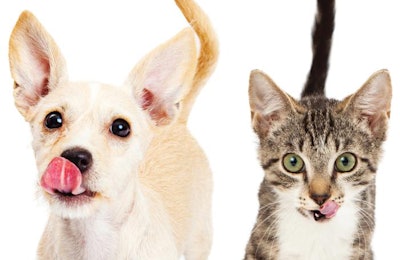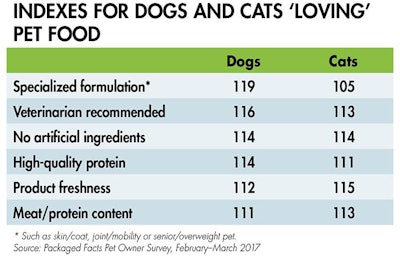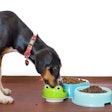
EDITOR’S NOTE: This article is a follow-up from a piece in June 2017’s issue of Petfood Industry magazine, which discussed the preferences of pet owners themselves.
As argued in the first part (see the June 2017 issue of Petfood Industry magazine) article, the most basic commercial pet food choice that pet owners make — dry pet food vs. wet, or both — follows from complicated interplay between pet owner points of view and the preferences of demonstrative pets.
To at least attempt to give pets their own say: Packaged Facts survey data from February/March 2017 on pet preference for “crunchy” over “soft, wet” pet food show the expected skews (see Figure 1). Pet parents who own dogs are slightly more likely to agree that their pets prefer crunchy pet food (at 68 percent, vs. 64 percent among cat owners), while pet owners who own cats are somewhat more likely to agree that their pets prefer wet (at 57 percent, vs. 51 percent among dog owners).

FIGURE 1: The majority of pet owners seem to believe that their pets prefer crunchy food to wet, and less than 10 percent of either dog or cat owners seem certain that their pets do not prefer crunchy pet food. Many pet owners agree to some extent that their pets prefer soft, wet pet food, but their certainty does not appear in the same numbers as those asked about crunchy pet food preference. As might be expected, a higher percentage of cat owners believe this preference exists than dog owners.
How pet owner bias affects perceived pet preferences
Factoring in that the expression “fighting like cats and dogs” dates back to the 1500s, however, cats and dogs show a surprising degree of harmony on this question, if pet parents are to be believed. Nor does the reported symmetry here between cats and dogs correspond to purchasing dynamics by product type (53 percent of cat owners buy wet pet food, vs. only 37 percent of dog owners) or category shares (dry dog or cat food racks up twice the sales as wet). Above and beyond pragmatic considerations such as price and convenience, then, what types of factors are at play when pet owners decide to buy dry pet food vs. wet?
To start with the positive: Dog owners who strongly agree that they “enjoy buying products that pamper my pet” are not only 13 percent more likely than average to buy wet dog food, but are 44 percent more likely (at 36 percent, vs. 25 percent of dog owners overall) to strongly agree that their dogs prefer their pet food moist.
Conversely, to go negative: Wet pet food’s unpleasant smell and messiness have long been considered a drawback, vis-à-vis dry pet food. Correspondingly, cat owners who strongly agree that they “avoid buying pet foods that have a strong smell” are not only 26 percent less likely than average to buy wet cat food, but are 37 percent more likely (at 41 percent, vs. 30 percent cat owners overall) to strongly agree that their cats prefer crunchy pet food.
However biased pet owner perceptions may be, things seem to come out in the wash. Among dog owners, 61 percent strongly agree and 36 percent at least somewhat agree that their dog “loves” its pet food. Among cat owners, similarly, 59 percent strongly agree and 38 percent somewhat agree that their cats love their pet food.
The percent who “strongly agree” that their pets love their food notches up from 61 percent to 66 percent among dog owners who feed their dogs wet pet food as well as dry. It edges up but more modestly among cat owners who feed their cats both wet and dry pet food.
Effects of price and premiumization on pet desire
Where a pet food product falls along the price spectrum, from significantly above-average priced to significantly below, seems to have a very modest effect overall on winning over the taste buds of pets. “Free-form formulations” may move the needle a little more, especially in the case of corn-free formulations for dogs or artificial ingredient-free formulations for cats.
There is a more significant uptick among dog owners who give their pets specialized formulations such as skin & coat — these dog owners are 19 percent more likely (or an index of 119; see Table 3) to report that their pet loves its dog food. Veterinarian-recommended formulas also seem to win over dogs disproportionately. Felines remain a bit more finicky, except in the case of product freshness.

TABLE 1: Perhaps unsurprisingly, pet owners whose pets eat specialized pet food formulas say their pets enjoy their food.
The latest pet food market trends
www.petfoodindustry.com/topics/222
More Packaged Facts research on the US pet market
















